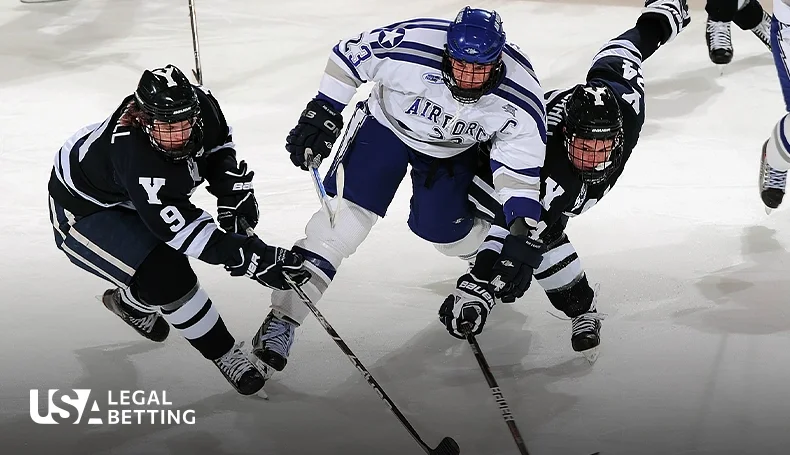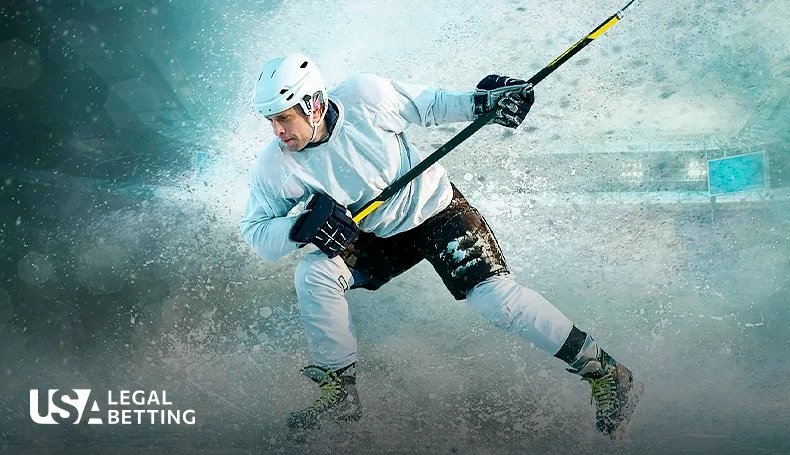Now that you’re considering getting into betting on the NHL, we want to provide an in-depth guide on how to best approach it without any issues.
Below, we’ll discuss things such as the types of bets, understanding the sites, strategies, key terms, and more.
Understanding NHL Betting Sites
As discussed above and throughout this page, finding and understanding the best NHL betting app involves examining the variety of hockey markets, competitive odds, user-friendly interfaces, excellent promotions and bonuses, and more.
Each of these elements creates an experience that’ll keep you coming back each time you want to wager on the NHL.
At the same time, it’s important to remember that you can play as many of these as you want. This isn’t a situation where you pick only one and can’t play elsewhere. If you’re in a state with multiple legal online NHL betting sites, you can create an account at all of them.
Types of NHL Bets
There are numerous ways to bet on the NHL and we have betting guides available for most of what you’ll read below. Here’s a quick summary of each.
- Moneyline: Pick which team you think will win the game.
- Puck Line: Similar to the point spread, the puck line is actually more similar to baseball’s run line. This number is always set at 1.5 and provides handicap to the game. A team will either be +1.5 or -1.5 and you need to pick whether or not a team will cover that run line. If you wager on a team at -1.5 and the win 4-3, you’ll lose the bet because they failed to win by two goals or more.
- Totals: Bet on the combined number of goals scored in a game.
- Futures: Bet on events such as player awards, playoff success, and division titles. The odds shift throughout the season.
- Parlays: Package multiple games together onto one betslip. The odds increase for each game added, but remember that in order for a parlay ticket to cash, all “legs” on it must succeed. If you have three games on a parlay and only two wins, you lose the wager.
- Prop Bets: The most common prop bets for hockey betting are player props. Instead of betting on the team's success, you’ll wager based on individual statistical performance. This could be for the number of goals scored, assists, goals saved, and more.
NHL Betting Odds Explained
With these hockey betting sites mentioned above, you’ll run into odds that are listed with a “-” or “+.”
To best understand these, let’s think about them through the lens of winning or wagering $100.
For “+” odds, this is considered the underdog. If you place a $100 wager on this and win, you’ll win the amount listed with the odds. For example, if the odds are +200, you wager $100 and win, you’ll get $200.
For “-” odds, this is the favored team. For these, you’ll need to wager the number linked to the odds to win $100. For example, if a team is -140, you must wager $140 to win $100.
As mentioned with the puck line, you’ll find either -1.5 or +1.5. These wagers will often have odds at or around -110, but for the puck line itself, here’s how to approach it.
- At -1.5, a team needs to win by two goals or more.
- At +1.5, the team needs to win outright or lose by one goal or less.
NHL Betting Strategies and Tips
- Set a Budget: Thies goes for all sports betting, but we recommend you set yourself up with a budget and stick to it. For example, if you deposit $100 to wager with, keep wagers between $1 and $10 each for longevity.
- Watch the Injury Report: The absence or status of key players can thoroughly change the thought-process of a wager. Determine whether a player is out or, if they’re going to play, how severe is the injury.
- Home-Ice Advantage: According to numerous studies, the home-ice teams tend to win moneyline wagers at a higher rate. During the 2022-23 season, home teams won the moneyline in regulation 53.10% of the time.
- Analyze Key Statistics: Before making any wager, you should always do your best to examine the key stats. One advanced stat that can help is the Corsi For Percentage (CF%). This is a stat that measures the shot attempts by a team compared to their opponent. There are plenty more statistics to consider, too, such as points, goals, assists, and more.
NHL Betting Key Terms
- Power Play: A power play happens in hockey when one team gains an advantage over the other team based on the number of players on the ice. For example, if a player commits a penalty and heads to the penalty box, there could be a situation where there’s a 5-4 power play, meaning the other team has one more player available on the ice.
- Short-Handed: This is a term that aligns with a power play. It simply indicates the numerical disadvantage, whereas power play is the name of the situation on the ice.
- Shootout: A shootout is a tie-breaking method used in hockey. While a game will have an overtime period, if the game remains tied after that, a shootout occurs.
- Hat Trick: This is when a player scores three goals.
- Unit: This is a term used to describe your average bet amount. So, if you see an analysis that says to “wager one unit,” this would indicate what your typical wager amount is.
- Regulation: This is used to describe the 60 minutes in a hockey game across three 20-minute periods.
- Hedge: This term describes wagering on the other side of a wager in an attempt to minimize losses or, if timed right, a small profit. You can use live betting to your advantage with this.
- Juice/Vig: If you see betting odds at -110, the 10 in that is considered the “commission” paid to the sportsbook. You’ll need to bet $11 to win $10 instead of it being “equal money.”
Live Betting on NHL Games
Live betting is available and can be done with NHL and other hockey games. This is an experience that allows you to wager on games as they progress. The markets mentioned above, such as the moneyline, totals, props, and more will remain available, but the odds switch as the game evolves. So, if a team goes up 1-0, their moneyline odds may be different than their pre-game odds.
At the best online NHL betting sites, you’ll be provided with a page dedicated to each game. This game will display all available markets and, most of the time, a live track that updates you with things such as goals, shots on goal, power plays, results of shootouts, and more.
Some sites even go a step further and have key statistics listed such as all of those mentioned above so you can make betting decisions without needing to watch the game if you’re unable to.
While we recommend actually watching the game when live betting, we know that’s not always possible, so having a live tracker and stats on the screen makes it that much easier, especially when on the road.
NHL Betting Trends and Analytics
Before making any wager on any sport, it’s important to have a grasp of the statistics within each sport so you can truly evaluate the advantages and disadvantages of each team. We mentioned one stat above with the Corsi For Percentage (CF%), but there’s of course plenty more than that, including Fenwick, PDO, xG, and more.
For newer players, exploring more “approachable” stats like goals scored, goals conceded, power play efficiency, and more provides a safe baseline for what to examine before placing any bets.
Examining things such as injuries and how they impact lineups can also play a major role.
Understanding NHL Line Movement
From the time odds are posted until the game starts, they will change. This change is known as “line movement” and is something you can monitor before placing a bet. A popular situation for this could be waiting for an injury. You could take a risk and assume a player is playing and perhaps get more advantageous odds, but at the same time, you could wait to hear if he’s in or out and bet accordingly.
Additionally, lines can shift due to the overall money coming in on a certain side or if a bettor that a sportsbook considers “sharp” places a big wager.
As always, we recommend comparing multiple NHL betting sites before making a wager to see which gives you the best odds.






.svg)










